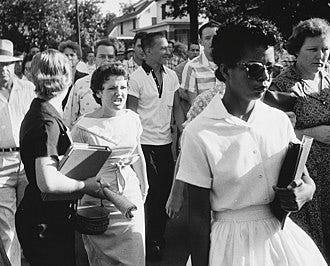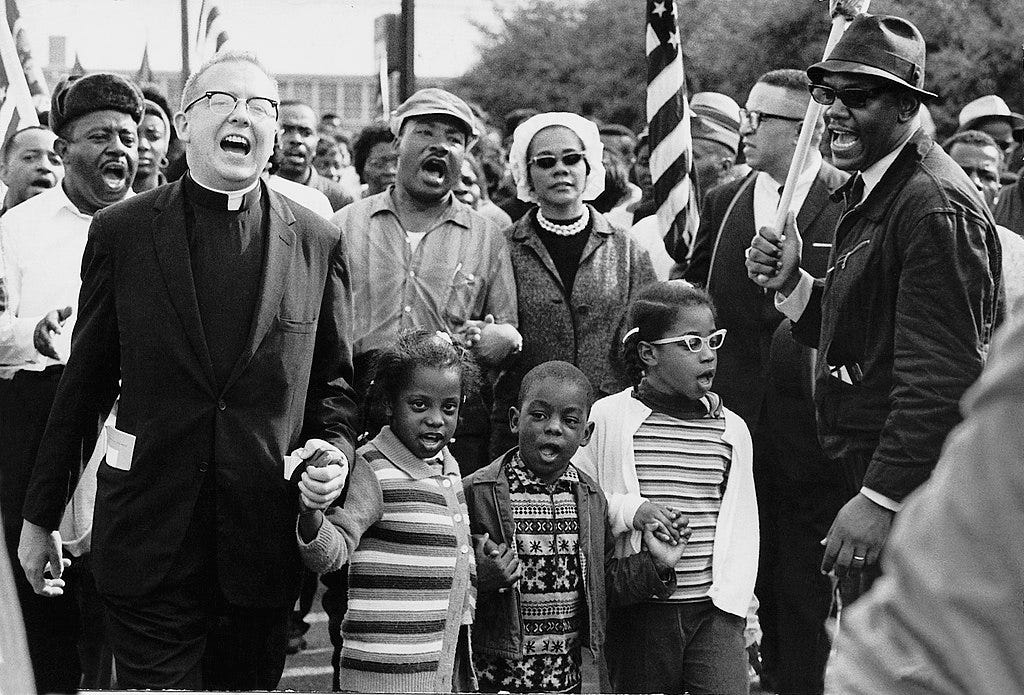Hazel Bryan shouts at Elizabeth Eckford, one of the Little Rock 9, a group of 9 African American students attempting to integrate Little Rock Central High School on September 4, 1957 (photo Will Counts, public domain)
CIVIL RIGHTS ERA: 1950s and 60s
1) Little Rock, Arkansas / Washington, DC, September 4-25, 1957
The first attempt to desegregate Southern schools after the Supreme Court’s landmark Brown v. Board of Education ruling of May 17, 1954, began on September 4, 1957, in Little Rock, Arkansas. The attempt failed, however, when Arkansas Governor Orval Faubus, under the guise of preventing a riot, deployed Arkansas National Guard troops to block the entrance to Little Rock Central High School to prevent the school’s integration by 9 African American students, who became known as the Little Rock 9.[1]
In response, on September 25—over the objections of Faubus but at the urging of Little Rock Mayor Woodrow Wilson Mann—President Dwight Eisenhower, after invoking the Insurrection Act of 1807, federalized the entire, 10,000-member Arkansas National Guard and sent in the Army’s 101st Airborne Division to protect the nine students and enable their integration of the school.[2]
2) Selma, Alabama / Washington, DC, March 7-25, 1965
The first Selma March to Montgomery, Alabama, March 7, 1965, named “Bloody Sunday” after marchers were brutally beaten by Alabama Highway Patrol troopers, and Rev. James Reeb, far left, was killed by white supremacists. Others in the picture: Dr. Martin Luther King and his wife, Coretta, center rear; and Rev. Ralph Abernathy, far right, with his three children, left to right, Donzaleigh Abernathy, Ralph David Abernathy, 3rd, and Juandalynn R. Abernathy (Abernathy Family Photos, public domain)
The first march for voting rights from Selma to Montgomery, Alabama, on March 7, 1965, ended disastrously for the marchers, but it was a pivotal moment for voting rights in the US. The gruesome violence perpetrated by the Highway Patrol against the peaceful marchers at the Edmund Pettus Bridge and the killing of Rev. James Reeb galvanized the country behind the long overdue need for voting rights reform in the Jim Crow South and moved President Lyndon Johnson on March 25 to push Congress to pass a Voting Rights Act.[3]
Back in Alabama, a second Selma march had been turned around by Martin Luther King to avoid another violent confrontation. But after US District Judge Frank Minns Johnson lifted a restraining order on a third march on March 17, LBJ—over the opposition of Governor George Wallace—federalized the Alabama National Guard to ensure the marchers’ safety. And on March 25, after moving through areas where not a single Black person had the right to vote, the marchers made it without incident to the state capitol and presented a voting rights petition to the governor’s office.[4] Congress went on to pass the Voting Rights Act and LBJ signed it into law on August 6, 1965.
THE TRUMP ERA, 2010s and 20s
LA freeway demonstration on June 8 in protest of ICE (Immigration and Customs Enforcement) and President Trump’s deployment of Nation Guard troops (photo Jason Armond/Los Angeles Times)
Los Angeles, California / Washington, DC, June 6-TBD, 2025
Political protest—sometimes violent, sometimes riotous—is nothing new to LA. One might say the City of Angels invented the modern-day political uprising with the Watts Rebellion of 1965, when National Guard troops were deployed by LBJ at the request of Democratic Governor Edmund G. “Pat” Brown. The Guard was called in again in 1992, by President George H.W. Bush at the behest of Gov. Pete Wilson, to quell the outburst following the not-guilty verdicts in the Rodney King beating trial. But the mass protest and considerable vandalism that accompanied George Floyd’s murder in 2020, which spread throughout the country, fell well short of the need for a National Guard presence, and none was requested by the governor or deployed by President Trump 1.0.
Not that he wouldn’t have loved to jump into the fray, as evidenced by his actually sending National Guard troops from 11 states into Washington DC during the George Floyd protests, over the objection of Mayor Muriel Bowser but with no governor to sidestep because DC isn’t a state. He also considered deploying the military in other states but decided against it because, as he stated at the time, “We have to go by the laws. . . . We can't call in the National Guard unless we're requested by a governor.”[5]
Infamous last words.
For in LA on June 7, 2025, emboldened by the Supreme Court’s presidential immunity ruling, voters’ knee-jerk anti-immigrant animus, and a vengeful tic against California and Los Angeles, wanna-be Emperor Trump conveniently forgot about having “to go by the laws,” and then some.
There was precedence for his actions, as we’ve seen. Like Ike in 1957 and LBJ in 1965, Trump deployed the National Guard—and a la Ike’s Army Division, even the Marines—without the request, indeed over the strenuous objections, of both California Governor Gavin Newsom and LA Mayor Karen Bass. But that’s where Trump’s resemblance to his Republican and Democratic predecessors, and the era during which they governed, vanishes in a cloud of white supremacist smoke.
Eisenhower and Johnson, in tune with a nation at long last making strides toward realizing its lofty ideal of liberty and equality for all, were using the military to protect partially liberated Black people still endangered by an intransigently racist relic of the past. While Trump’s ongoing miliary occupation, allegedly to protect ICE officers, is the complete flipside of that ideal. It operates on behalf of that racist, sexist, homophobic relic, whose revival he’s boosted and upon whose support he depends, and only serves to further endanger an unjustly maligned, non-White segment of the population. Ike and LBJ were showing the better angels of their and the nation’s nature; Trump is dredging up the country’s worst instincts to feed his megalomania and imperial designs.
But are his actions legal?
Trump, as of June 11, has threatened to but not yet invoked the Insurrection Act of 1807, which both Ike and LBJ did, as did President Bush in 1992, though with the governor’s consent. This act allows the president “to use the military against American citizens on domestic soil, including in nonconsenting states, to quell an armed rebellion or extreme civil unrest.”[6] And while the LA protest—largely peaceful with pockets of admittedly deplorable vandalism—so far hardly qualifies, it appears to be Trump’s scheme to provoke the situation to that end.
So that his claim, “If we didn’t get involved, right now Los Angeles would be burning,” is as usual a distorted mirror of the truth, since it was precisely the arrival of the National Guard that sparked the bulk of the violence.[7] Not to mention that ICE itself has been accused by the ACLU (American Civil Liberties Union) and other observers of committing violence to the Constitution by not issuing warrants before its arrests of suspected undocumented immigrants.[8]
In lieu of the Insurrection Act, Trump cited Section 12406 of the US Code for his deployment, which gives the president the authority to call in the National Guard when “there is a rebellion or danger of a rebellion against the authority of the Government of the United States.” The perhaps unforeseen catch here is that this statute “applies only to the National Guard and not the US Armed Forces more broadly. It also states that the order to call in National Guard troops should be issued by governors.”[9]
And this is apparently where Gov. Newsom, in his suit filed against the administration on June 9, hopes to hoist Trump on his own petard.[10] And given TACO’s batting average with the courts so far, it could be an easy out—or, even if he loses, the worst-case scenario we’ve all been dreading.
My glass remains half full.
* * * * * * * * * *
NOTES
Thanks to Karen Brook and Chava Bahle for their assistance.
[1] Elizabeth Jacoway, https://web.archive.org/web/20160126015035/http://www.washingtonpost.com/wp-dyn/content/article/2007/03/16/AR2007031600131.html.
[2] Jean Edward Smith, Eisenhower in War and Peace (Random House, 2012), 723.
[3] Tom Wicker, “Johnson Urges Congress at Joint Session to Pass Law Insuring Negro Vote,” New York Times, March 15, 1965.
[4] Jack Mallon, March 26, 1965, https://www.nydailynews.com/2015/03/06/rev-martin-luther-king-jr-and-demonstrators-reach-montgomery-from-selma-in-1965.
[5] Abdallah Fayad, June 9, 2025, https://www.vox.com/politics/416105/trump-national-guard-newsom-la-protests-immigration; Sharon Knolle, June 10, 2025, https://www.yahoo.com/news/trump-said-t-deploy-national-223947002.html.
[6] Fayad.
[7] Jack Moore, Riley Hoffman, Kevin Shalvey, and Emily Shapiro, June 10, 2025, https://abcnews.go.com/US/live-updates/la-immigration-protests-live-updates-trump-deploys; Rachel E. VanLandingham, June 9, 2025, https://www.msnbc.com/opinion/msnbc-opinion/trump-los-angeles-ice-protests-military-national-guard-rcna211931.
[8] Aruna Shantha, June 7, 2025, https://ziradaily.com/news/101055.
[9] Fayad.
[10] Graham Kates and Joe Walsh, June 9, 2025, https://www.cbsnews.com/news/trump-national-guard-california-lawsuit-gavin-newsom.






